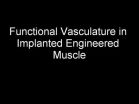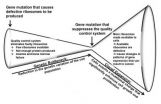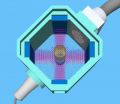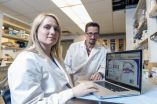(Press-News.org) (PHILADELPHIA) -- The code for every gene includes a message at the end of it that signals the translation machinery to stop. Some diseases, such as cystic fibrosis and Duchenne muscular dystrophy, can result from mutations that insert this stop signal into the middle of an essential gene, causing the resulting protein to be truncated. Some antibiotics cause the cell's translation machinery to ignore the stop codons and are therefore being explored as a potential therapy for these diseases. But new research reported online in Proceedings of the National Academy of Sciences (the week of March 31st) shows that this approach could come with the price of triggering autoimmune disease.
"It's worth thinking about this as a potential mechanism for autoimmunity," says co-lead investigator, Laurence Eisenlohr, Ph.D., a professor in the department of Microbiology and Immunology at Thomas Jefferson University.
Autoimmune diseases such as Crohn's disease, eczema, or lupus are caused by an immune system that attacks normal components of various tissues of the body. The immune system attacks these normal tissues just as it would attack tissue infected by a bacteria or virus. What causes the immune system to malfunction in some people but not others, however, has been a puzzle. "Often, the trigger happens years before the disease has been diagnosed," says Dr. Eisenlohr.
The researchers looked at a class of antibiotics that includes gentamicin because these antibiotics have the unique property of inducing cells to read through stop codons in the genetic code – producing a longer protein product. This mechanism can help save the translation of mutated genes whose processing is interrupted by aberrant stop codons, such as in cystic fibrosis. However, when cellular machinery reads through normal stop codons, it could create abnormally elongated proteins in the cell. Pieces of these abnormal proteins may be presented to the immune system as a part of normal protein processing, where they could be detected by the immune system. At least, that's the theory.
To test this theory, Eisenlohr's team, in collaboration with a translation biology group at the University of Utah led by Michael Howard, Ph.D., used a gene that they knew would get presented to the immune system and added a stop codon in the middle of it. They then inserted this gene into a mammalian cell line. Because the stop codon truncates the gene, normal cells did not produce the protein. However, when the researchers treated the cells with gentamicin, they began to detect the protein on the surface of cells.
While a very low number of these proteins were produced – too little to detect by normal biochemical tests – the T cells of the immune system are sensitive enough to pick up these miniscule amounts. Indeed, the group showed that the immune cells could detect the protein produced by gentamicin-treated cells, even at low quantities.
To test whether this process was active even in normal cells that weren't expressing an experimental gene, first author Elliot Goodenough exposed the HeLa human cell line to gentamicin and then searched for novel peptides presented on the surface of the cells. He identified 17 peptides that hadn't been characterized before in cells treated with gentamicin and showed that the peptides were presentable to the immune system. "The results suggest that gentamicin can cause cells to display novel protein fragments to the immune system," says Goodenough. In other words, "what may be garbage biologically may be important immunologically," says Eisenlohr.
However, presenting an antigen to the immune system does not guarantee that it will activate the kind of immune response that initiates autoimmunity. But because gentamicin is usually used to treat infections, "all of the right conditions are in place to potentially initiate autoimmunity," says Eisenlohr. The inflammation associated with bacterial diseases gives a signal to immune cells that the peptides they encounter are dangerous. So even as gentamicin fights the bacteria causing the infection, it also causes normal cells to produce abnormal proteins that are presented to the immune system and have a potential of initiating an autoimmune reaction.
"A number of autoimmune diseases are thought to be triggered by infections," says Eisenlohr. "The results of this study suggest that certain antibiotics used to treat those infections may also contribute to that trigger."
The next steps, says Eisenlohr, could be to look at population data to see whether use of gentamicin correlates with higher rates of autoimmune diseases, as well as testing whether the peptides generated during gentamicin treatment actually do cause autoimmunity in a mouse model of the disease.
INFORMATION:
This work was supported by National Institutes of Health Grants R01AI039501 (to L.C.E.), R01AI100561 (to L.C.E.), and R21NS083884 (to M.T.H.); and Science Foundation Ireland Grant 12/IP/1492 (to J.F.A.).The authors declare no conflicts of interest.
For more information, contact Edyta Zielinska, (215) 955-5291, edyta.zielinska@jefferson.edu.
About Jefferson
Thomas Jefferson University (TJU), the largest freestanding academic medical center in Philadelphia, is nationally renowned for medical and health sciences education and innovative research. Founded in 1824, TJU includes Jefferson Medical College (JMC), one of the largest private medical schools in the country and ranked among the nation's best medical schools by U.S. News & World Report, and the Jefferson Schools of Nursing, Pharmacy, Health Professions, Population Health and the Graduate School of Biomedical Sciences. Jefferson University Physicians is TJU's multi-specialty physician practice consisting of the full-time faculty of JMC. Thomas Jefferson University partners with its clinical affiliate, Thomas Jefferson University Hospitals.
Article reference: E Goodenough et al., "Cryptic Q:1 MHC class I-binding peptides are revealed by
aminoglycoside-induced stop codon read-through into the 3' UTR," PNAS, doi: 10.1073/pnas. 1402670111, 2014.
Can antibiotics cause autoimmunity?
Antibiotics being explored for the treatment of cystic fibrosis and muscular dystrophy have the potential to trigger autoimmune disease
2014-03-31
ELSE PRESS RELEASES FROM THIS DATE:
Self-healing engineered muscle grown in the laboratory
2014-03-31
VIDEO:
After veins grow into the implanted engineered muscle fibers, blood cells can be seen traveling through them, sustaining and nourishing the new tissue.
Click here for more information.
DURHAM, N.C. -- Biomedical engineers have grown living skeletal muscle that looks a lot like the real thing. It contracts powerfully and rapidly, integrates into mice quickly, and for the first time, demonstrates the ability to heal itself both inside the laboratory and inside an animal.
The ...
Ancient whodunit may be solved: The microbes did it!
2014-03-31
Evidence left at the crime scene is abundant and global: Fossil remains show that sometime around 252 million years ago, about 90 percent of all species on Earth were suddenly wiped out — by far the largest of this planet's five known mass extinctions. But pinpointing the culprit has been difficult, and controversial.
Now, a team of MIT researchers may have found enough evidence to convict the guilty parties — but you'll need a microscope to see the killers.
The perpetrators, this new work suggests, were not asteroids, volcanoes, or raging coal fires, all of which have ...
Experimental cancer drug reverses schizophrenia in adolescent mice
2014-03-31
Johns Hopkins researchers say that an experimental anticancer compound appears to have reversed behaviors associated with schizophrenia and restored some lost brain cell function in adolescent mice with a rodent version of the devastating mental illness.
The drug is one of a class of compounds known as PAK inhibitors, which have been shown in animal experiments to confer some protection from brain damage due to Fragile X syndrome, an inherited disease in humans marked by mental retardation. There also is some evidence, experts say, suggesting PAK inhibitors could be used ...
Possible explanation for human diseases caused by defective ribosomes
2014-03-31
Ribosomes are essential for life, generating all of the proteins required for cells to grow. Mutations in some of the proteins that make ribosomes cause disorders characterized by bone marrow failure and anemia early in life, followed by elevated cancer risk in middle age. These disorders are generally called "ribosomopathies."
How can ribosomopathies first appear as diseases caused by too few cells, but later turn into diseases caused by too many cells? This paradox has puzzled the scientific community for years. A new study, which uses a genetic approach to examine ...
Oxygen depletion in the Baltic Sea is 10 times worse than a century ago
2014-03-31
This news release is available in German. After several years of discussions, researchers from Aarhus University (Denmark), Lund University (Sweden) and Stockholm University (Sweden) have determined that nutrients from the land are the main cause of widespread areas of oxygen depletion. The results were published on 31 March in the prestigious American journal Proceedings of the National Academy of Sciences.
Nutrients are the villain
The deepest areas of the Baltic Sea have always had a low oxygen content. The inflow of fresh water is actually limited by low thresholds ...
Scientists understand how E. coli clone has become globally distributed
2014-03-31
Scientists have for the first time come closer to understanding how a clone of E. coli, described as the most important of its kind to cause human infections, has spread across the world in a very short time.
E. coli clone ST131 is one of the leading causes of urinary tract and blood stream infections and has crossed the globe at a rapid rate. Worryingly, members of this clone are becoming more resistant to antibiotics. As an indication of scale, more than half of all women will suffer a urinary tract infection at least once in their lives. An international team of scientists, ...
Researchers announce first phononic crystal that can be altered in real time
2014-03-31
Using an acoustic metadevice that can influence the acoustic space and can control any of the ways in which waves travel, engineers have demonstrated, for the first time, that it is possible to dynamically alter the geometry of a three-dimensional colloidal crystal in real time.
The colloidal crystals designed in the study, called metamaterials, are artificially structured materials that extend the properties of existing naturally occurring materials and compounds. The research by academics from the University of Bristol's Department of Mechanical Engineering is published ...
Weaker gut instinct makes teens open to risky behavior
2014-03-31
DURHAM, N.C. -- Making a snap decision usually means following your initial reaction -- going with your gut. That intuitive feeling sprouts from the limbic system, the evolutionarily older and simpler part of the brain that affects emotion, behavior and motivation.
But during adolescence, the limbic system connects and communicates with the rest of the brain differently than it does during adulthood, leaving many adolescents vulnerable to riskier behaviors, according to Duke University researchers.
"We know adolescence is a time of profound social change. It's also ...
New tool helps young adults with sickle cell disease in the transition to adult care
2014-03-31
(Boston) – Child and adolescent hematologists at Boston Medical Center (BMC) have developed a tool to gauge how ready young adults with sickle cell disease are for a transition into adult care. In a new article for the Journal of Pediatric Hematology/Oncology, Amy Sobota, MD, MPH, and her collaborators have shown that a questionnaire geared to the needs of young adults with sickle cell disease can pinpoint areas of need before the patient goes into an adult clinic.
BMC's sickle cell disease transition clinic, which is unique in Boston, was established in 2008 and serves ...
Vibration may help heal chronic wounds
2014-03-31
Wounds may heal more quickly if exposed to low-intensity vibration, report researchers at the University of Illinois at Chicago.
The finding, in mice, may hold promise for the 18 million Americans who have type 2 diabetes, and especially the quarter of them who will eventually suffer from foot ulcers. Their wounds tend to heal slowly and can become chronic or worsen rapidly.
Timothy Koh, UIC professor of kinesiology and nutrition in the UIC College of Applied Health Sciences, was intrigued by studies at Stony Brook University in New York that used very low-intensity ...
LAST 30 PRESS RELEASES:
Tracing the quick synthesis of an industrially important catalyst
New software sheds light on cancer’s hidden genetic networks
UT Health San Antonio awarded $3 million in CPRIT grants to bolster cancer research and prevention efforts in South Texas
Third symposium spotlights global challenge of new contaminants in China’s fight against pollution
From straw to soil harmony: International team reveals how biochar supercharges carbon-smart farming
Myeloma: How AI is redrawing the map of cancer care
Manhattan E. Charurat, Ph.D., MHS invested as the Homer and Martha Gudelsky Distinguished Professor in Medicine at the University of Maryland School of Medicine
Insilico Medicine’s Pharma.AI Q4 Winter Launch Recap: Revolutionizing drug discovery with cutting-edge AI innovations, accelerating the path to pharmaceutical superintelligence
Nanoplastics have diet-dependent impacts on digestive system health
Brain neuron death occurs throughout life and increases with age, a natural human protein drug may halt neuron death in Alzheimer’s disease
SPIE and CLP announce the recipients of the 2025 Advanced Photonics Young Innovator Award
Lessons from the Caldor Fire’s Christmas Valley ‘Miracle’
Ant societies rose by trading individual protection for collective power
Research reveals how ancient viral DNA shapes early embryonic development
A molecular gatekeeper that controls protein synthesis
New ‘cloaking device’ concept to shield sensitive tech from magnetic fields
Researchers show impact of mountain building and climate change on alpine biodiversity
Study models the transition from Neanderthals to modern humans in Europe
University of Phoenix College of Doctoral Studies releases white paper on AI-driven skilling to reduce burnout and restore worker autonomy
AIs fail at the game of visual “telephone”
The levers for a sustainable food system
Potential changes in US homelessness by ending federal support for housing first programs
Vulnerability of large language models to prompt injection when providing medical advice
Researchers develop new system for high-energy-density, long-life, multi-electron transfer bromine-based flow batteries
Ending federal support for housing first programs could increase U.S. homelessness by 5% in one year, new JAMA study finds
New research uncovers molecular ‘safety switch’ shielding cancers from immune attack
Bacteria resisting viral infection can still sink carbon to ocean floor
Younger biological age may increase depression risk in older women during COVID-19
Bharat Innovates 2026 National Basecamp Showcases India’s Most Promising Deep-Tech Ventures
Here’s what determines whether your income level rises or falls
[Press-News.org] Can antibiotics cause autoimmunity?Antibiotics being explored for the treatment of cystic fibrosis and muscular dystrophy have the potential to trigger autoimmune disease




